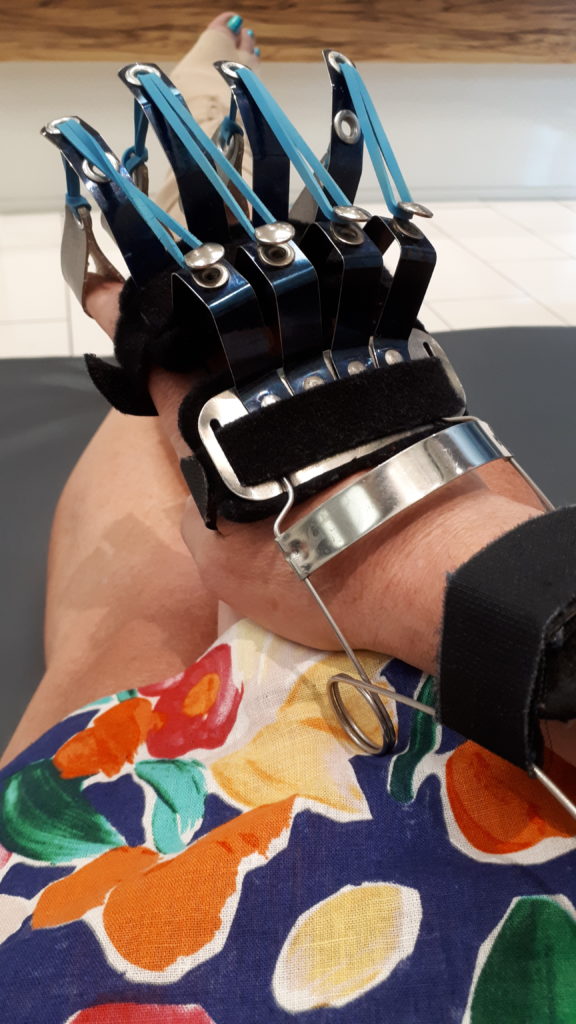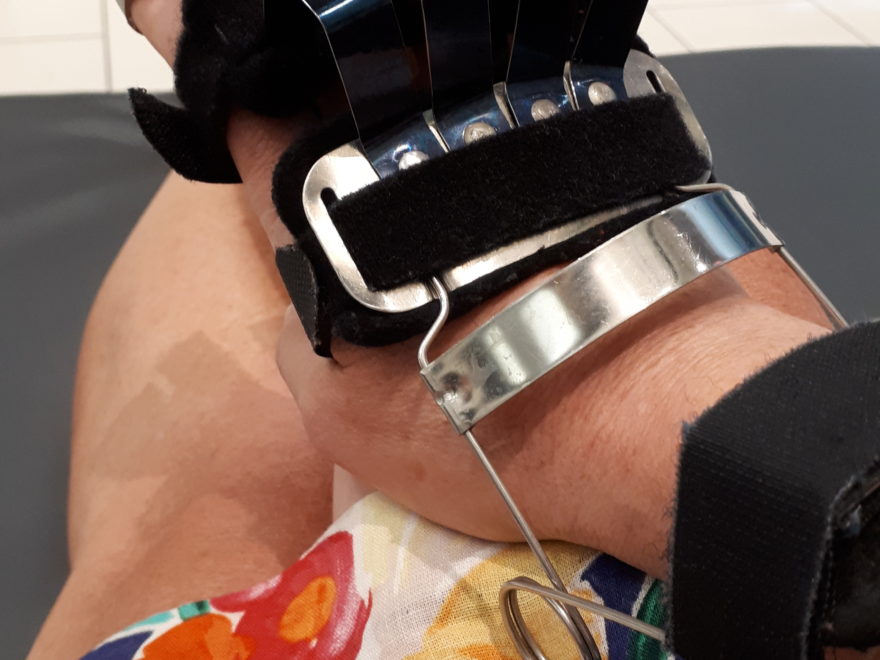This morning I was at a different hospital, for a change. I say ‘for a change’ because my rare disease is treated at one specific hospital. Complex Regional Pain Syndrome (CRPS), as you might guess from its name, is considered to be a chronic pain condition.
It’s best treated at a multidisciplinary pain clinic, in my case at the Alan Edwards Pain Management Unit (AEPMU).(1) The AEPMU is housed within the Montreal General Hospital (MGH), which is one of the hospitals operated by the McGill University Health Centre (MUHC).
It’s like alphabet soup, isn’t it, all the abbreviations and acronyms in healthcare? I suppose I’m used to that, having served in the military – where there are acronyms for just about everything!
Here’s a good example; when I see BOGO, I don’t think of the Payless Shoes’ ‘buy one, get one’ half-off offer. I think ‘boots on ground, overseas’; the term used when one of my friends is being deployed overseas. Back to my story…
My appointment today was because of a referral from my dermatologist, to the dermatology department of the Jewish General Hospital (JGH). I won’t go into the reason for my dermatology appointment, though, because this post is about CRPS!
Wait a second, you’re probably thinking, didn’t she just say that her CRPS is treated at the AEPMU, not the JGH? You’re right, I did. Today’s post is about one of the ways in which I try to raise awareness of CRPS, among physicians and others working in healthcare.
A couple of weeks ago, I had an appointment with a new dermatologist. He’s the one who referred me to the JGH, for today’s appointment. When he asked about the odd-looking dynamic splint, that I wear on my right arm, I used his question as an opportunity. To do what? To raise awareness of CRPS! You can read that story by clicking on this link.
I was able to quickly gain his interest in the dermatological aspects of CRPS, by showing him two sentences from a medical journal – on my phone. The journal was JAMA Dermatology, which is for… dermatologists!
What’s fantastic, for raising awareness of CRPS, is when a medical journal tells a specialist that they should know about this disease. This journal article is a perfect example of this:
It is important for dermatologists to understand and recognize CRPS as a neurological disorder with major dermatologic implications.
The ability of dermatologists to identify and direct patients with this syndrome is a critical factor in determining the likelihood of favorable outcomes following diagnosis of CRPS.”(2)
Have I mentioned that I just love this JAMA Dermatology article?! Before my hospital appointment today, I made sure that I still had this article loaded onto my phone, along with a screenshot of those two sentences.
When I was called into the treatment room, a medical resident met with me first. She took my medical history, and asked about the referral from my dermatologist. She told me that there would be three other residents observing my appointment, as part of the training.
She then left the room, to present my case to the senior physician and the other residents. The five people who then filed into the examining room already knew what my appointment was for.
Once everyone was in the room, and the door to the treatment room was closed, the senior physician introduced himself to me. He told the trainees that he had some materials to prepare, and dosages to check, so they could ask me questions.
I was wearing my dynamic splint, so the first questions was about that – even though my appointment today was for something on my foot. Out came my phone, with the cover page of that medical journal article! While I was explaining to them that my splint was for CRPS, I showed each of them the title of the article on my phone:
“Dermatological Findings in Early Detection of Complex Regional Pain Syndrome”(1)
Before the senior doctor was ready to begin the medical procedure on my foot, I also had time to mention a few quick CRPS facts to the residents. That it’s considered to be both an autoimmune and a neuro-inflammatory condition, and that it’s best treated within a multidisciplinary pain clinic.
All four residents seemed to be interested in CRPS, and two of them thanked me for showing them the JAMA Dermatology article. By now the physician was ready to start the treatment on my foot, so I stopped talking about CRPS.
After the treatment, which was rather painful, one of the residents stayed with me while the others went on to the next appointment. She checked to see whether I had any questions.
Then she went over the doctor’s follow-up instructions with me, so I could tap them into my phone. I had explained that one of my CRPS symptoms now is that I have trouble with my short-term memory. Trouble remembering verbal instructions, for example.
When I’d finished typing the information into my phone, using only my left hand, she double-checked what I’d written. She made a correction for me, and we saved my note. While I’d been tapping away at my phone, she very happily told me that she’d be talking about that journal article with her husband that night.
He was also in medicine, and was specializing in chronic pain! There was an intriguing overlap between their two specializations, so she was going to ask him to read the JAMA Dermatology article – before they even talked that night. She said it would be a really interesting conversation for them as a couple, because they’d each be able to give their own perspectives. Based on their own specialized medical training.
This kind of conversation is often used for medical education by practicing physicians, in small groups. Discussing medical journal articles is a good, and fun, way for them to keep up with new information in medicine. These conversations even has a name, when they occur as regular events; Journal Clubs.
So I mentioned that they’d be having a kind of two-person Journal Club on CRPS, and she asked me how I knew about these events. I told her that I used to attend some of them, for bioethics-related topics, at another university hospital where I’d worked in the past. So she asked me whether I’d consider do an impromptu lunch-break Journal Club with the group of five residents I’d met during my treatment that morning. So, of course, I said yes!
It was only a 15-minute session, as they didn’t have a very long break, but it was fantastic to see their interest for the topic. A couple of them mentioned how “cool” it was to hear about this from a patient with the condition, who has also worked in a hospital and research environment.
As for that one resident who was going to speak with her husband about CRPS that evening, maybe her husband will mention CRPS to some of the residents and others he works with – at his hospital in Toronto, in both chronic pain and dermatology specializations. Maybe the other residents I met today will share this article with more trainees and other colleagues in medicine.
Wouldn’t it be fantastic if my 15-minute conversation this morning, with four residents, could trigger 5, 10, or even more conversations about CRPS? That could lead to a whole lot more trainees – and future physicians – knowing which symptoms could signal CRPS. Knowledge of those CRPS symptoms could, in turn, translate into patients being diagnosed and treated more rapidly than they are now.
If something that I’ve done could someday help another patient, another person, then the time and energy that I invest in awareness-raising and small-scale advocacy will have been worth it ‘-)
Have a great day, and thanks so much for following along on this adventure with me!
References:
(1) Alan Edwards Pain Management Unit: Treatment, Education, Research. McGill University. Online. Accessed 28 Sep 2018. Web:
https://www.mcgill.ca/paincentre/
(2) Kabani R, Brassard A. Dermatological Findings in Early Detection of Complex Regional Pain Syndrome. JAMA Dermatol. 2014;150(6):640–642. doi:10.1001/jamadermatol.2013.7459. Online. Accessed 28 Sep 2018. Web:
https://jamanetwork.com/journals/jamadermatology/fullarticle/1861486


